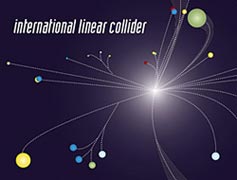

Thursday - March 22, 2007
SLAC Today is
available online at:
http://today.slac.stanford.edu
In this issue:
Colloquium: The Reference Design for the ILC, Costs and What's Next
Science Today: Mixed-up Quarks
St. Lawrence Quartet to Perform Today at Noon
Salvage Gives Old Supplies New Life
 |
 |
|
Thursday - March 22, 2007 |
Colloquium: The Reference Design for the ILC, Costs and What's Next The International Linear Collider (ILC) has reached an important moment in its evolution. At a press conference held on February 8th in Beijing, China, the International Committee for Future Accelerators (ICFA) announced the release of the ILC Reference Design Report. This report provides the first detailed description of the proposed electron-positron collider and the first cost estimate for the project. After the report's release, Under Secretary for Science Raymond Orbach stated that he imagines a timescale for completion of the ILC in "the mid-2020s, if not later." Where does the ILC stand now? The SLAC Users Organization and the Colloquium Committee have organized a special panel discussion to help explain the project's current status. On Monday, March 26, ILC Global Design Effort Director Barry Barish will present a 30-minute introduction to the ILC's features and design status. This will be followed by a panel discussion on the future of the project, moderated by Marty Breidenbach and featuring Barish, Jonathan Dorfan, Tor Raubenheimer, and Abe Seiden. The colloquium will take place at 4:15 p.m. on Monday, March 26, in Panofsky Auditorium. It can also be viewed here via live streaming video. |
||
|
|
||
 Mixed-up Quarks
|
St. Lawrence Quartet to Perform Today at Noon
Salvage Gives Old Supplies New Life
Items are sold on a first-come, first-served basis, between 7 a.m. and 3:30 p.m. on Wednesdays. Exact change and a minimum purchase of $10, not including tax, is required; salvage offers no refunds or returns, and profits remain in SLAC's general fund. Since space is limited, unsold items are dismantled and sent out as recyclable material. Other kinds of equipment that can't be reused on site, including oscilloscopes, vehicles, and electronics, are offered to other labs or government agencies in a Department of Energy excess equipment database. If items aren’t reutilized within about three weeks' time, they're auctioned at bid4assets.com, where anyone with internet access can bid for them. For more information about salvage and the equipment disposal process, contact Property Control Manager Leslie Normandin (x4350) or Salvage and Sales Manager Gus Venancio (x2329). |
Events (see all | submit)
Access (see all)
Announcements
|
| | ||
|
|
||
 <%
Response.AddHeader "Last-modified", getArticleDate()
'Response.AddHeader "Last-modified","Mon, 01 Sep 1997 01:03:33 GMT"
'Monday, December 06, 2010
%>
<%
Response.AddHeader "Last-modified", getArticleDate()
'Response.AddHeader "Last-modified","Mon, 01 Sep 1997 01:03:33 GMT"
'Monday, December 06, 2010
%>View online at http://today.slac.stanford.edu/. |
||